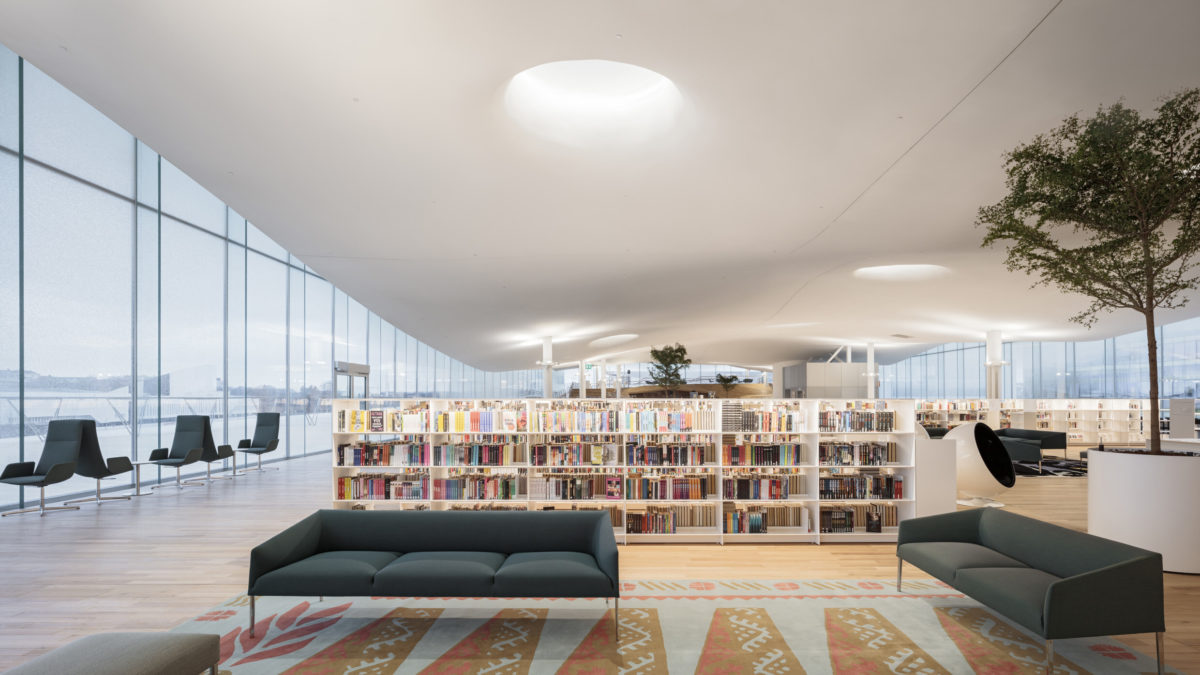Culture and leisure
Overview
Intelligent material management system

Tags
library material management system logisticsIMMS (Intelligent Material Management System) is an intelligent material management system for the entire library collection. The City Library’s collection contains approximately 1.8 million items. An intelligent material management system was acquired while the city library moved away from library-specific collections to one shared collection. With the change, the library wanted to enable moving the material freely between different libraries. The system was introduced in May 2019, after which it has been in use but still in the deployment phase. The system has made it possible to reach a situation where the majority of the collection now floats, i.e. moves freely between libraries.
With the floating material, customers can influence the offering of each library with their own activities. Returns influence the offerings of libraries. Library experts can modify system configurations based on reports and observations. The aim is to distribute the new material equally so that no library is in an unequal position based on its size. Thus the customers of different libraries can be served in an equal manner.
The service enables tracking and tracing of the item movements. The material can be located in real-time using RFID tags attached to the material. The material to be borrowed from the Helsinki City Library was labelled with RFID tags before the system was introduced. RFID tags are also used in transport units, check-out machines sorting points, and in special shelf identification.
The library system is not intended for logistical tracking of material, and therefore this new system effectively complements the data obtained on the movement of items. Library experts can control the flow of material between libraries with parameters and rules supported by the system. These control the filling level of library shelves in a way that allows the better presentation of materials to customers. The material hotel created during the introduction of the intelligent material management system balances, for example, seasonal overflows and shelf overflow during library renovations. Guests do not have physical access to the material hotel, but the material can be booked. The material hotel is located in the Pasila library building, close to the city library’s central sorter.
Furthermore, the system also makes it possible to reduce manual logistics. The material can be processed, for example, by moving the reservations box by box, when this was previously done on an item by item basis. Improving the handling of reservations is necessary as the number of reservations has risen sharply in recent years. Improving the efficiency of processing also enables staff to allocate working hours from logistics to other library work.
The service includes a mobile application used by library staff. With the help of the mobile application, the material can be transferred to the central sorter or to the library shelves, either box at a time or, if necessary, item at a time. It also allows staff to see item, shelf, or transport unit-specific information (current information, as well as the previous movements).The Danish Lyngsoe Systems have built the system in collaboration with Danish public libraries. The system only processes material data and not handle the personal data of customers at all.
Contact information
-
Department
- City library, Library Network Services
-
Contact team for inquiries
- Satu Holmberg
-
External suppliers
- Lyngsoe Systems
-
Contact email
- virva.nousiainen-hiiri@hel.fi
-
Contact phone
- 09-310 1691
More detailed information on the system
Here you can get acquainted with the information used by the system, the operating logic, and its governance in the areas that interest you.
- DatasetsShow More Show Less
-
Key data sources utilised in the development and use of the system, their content and utilisation methods. The different data sources are separated by subheadings.
Sierra ILS
Sierra ILS is a library system used by the Helsinki City Library (Innovative Interfaces Inc.). Sierra manages borrowing, returning and booking operations, as well as information related to the library’s production, e.g. customer information, procurement, availability of materials, descriptions and classifications of materials.. The IMMS system uses the following information from the Sierra database: Title id, title of the work, author’s name, language, type of material, number of pages, date of acquisition, item id, classification, possible genre, item status, location library and -department. The IMMS retrieves information from Sierra about new items, changes to items, and information about items that can complete a reservation request.
IMMS
The service utilises the following information created and maintained by library experts:
• Users; accounts and access rights • Floating codes and their definitions; these are used to determine how and where the material floats and to identify material for which floating is not appropriate (eg bookstore, local collections, etc.) • Averages of material dimensions (averages are often used) • Library structures: measurements of the shelf dimensions of each library and the contents at the shelf level • Levels of material groups to define their hierarchy • Library specific hierarchies for the material groups and their shelf dimensions • Library specific content and attachment of each material group to the shelf dimensions • Building exhibitions using an exhibition tool. Exhibitions built in this way can be used simultaneously, even in all libraries. For these exhibitions, filling is done automatically using the system. • Material lifecycle rules that can be used to determine the required number of materials at different times during its life cycle. • Transport units (box, cart, trolley) and their RFID tags • Exhibition furniture and their RFID tags • Numbered shelf dividers for reservation shelves and their RFID tags • RFID tags for sorting locations of check-in machines • The numbered shelf dividers of the material hotel and their RFID tags • Maintenance of genre entries in the material
The following parameters have been defined for the service by library experts:
• Security • Item grouping defaults • Default values for data dimensions • Automatic corrections • Automatic replenishment • Material search lists (for the mobile application) • Material sorting specifications • Determining the update time of library structures • Library system-related configurations • Automatic material lifecycle management • Floating structure
In addition, the following information from the library system (Sierra ILS) corrected by library experts will be used:
• Names of libraries and departments • Passivation of data from libraries in other cities in the consortium of libraries (Helmet), because the libraries are not included in IMMS. (However, the consortium of libraries (Helmet) has a common library system.)
- Data processingShow More Show Less
-
The operational logic of the automatic data processing and reasoning performed by the system and the models used.
Model architecture
IMMS utilises an Intelligent Distribution Algorithm for making real-time decisions for the item flow and maintaining strategies to optimise the algorithm. The Intelligent Distribution Algorithm is developed and owned by Lyngsoe Systems.
- Non-discriminationShow More Show Less
-
Promotion and realisation of equality in the use of the service.
The aim is to distribute the new material in such a way that no library is in an unequal position in relation to the new items. The floating of the material makes it possible to ensure equal access to the material. The intelligent material management system does not control the acquisition of materials, but only the distribution of the acquired material.
- Human oversightShow More Show Less
-
Human oversight during the use of the service.
The operation of the system is monitored and further developed by the library’s appointed experts through various reports and feedback from staff. The system vendor is responsible for the technical maintenance and support of the service.
- Risk managementShow More Show Less
-
Risks related to the system and its use and their management methods.
The risk level of the service is estimated to be low.
Was this information useful?
